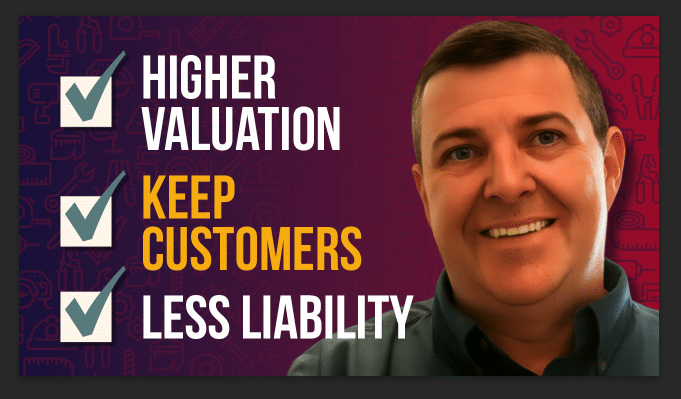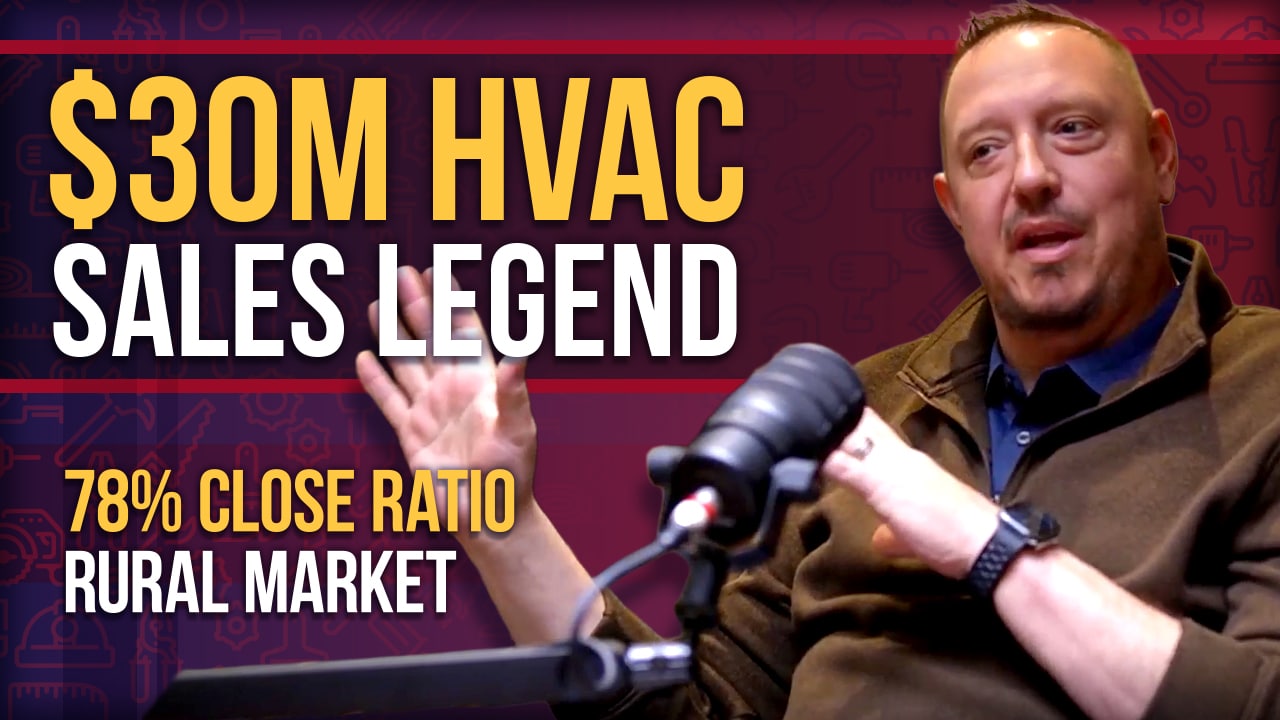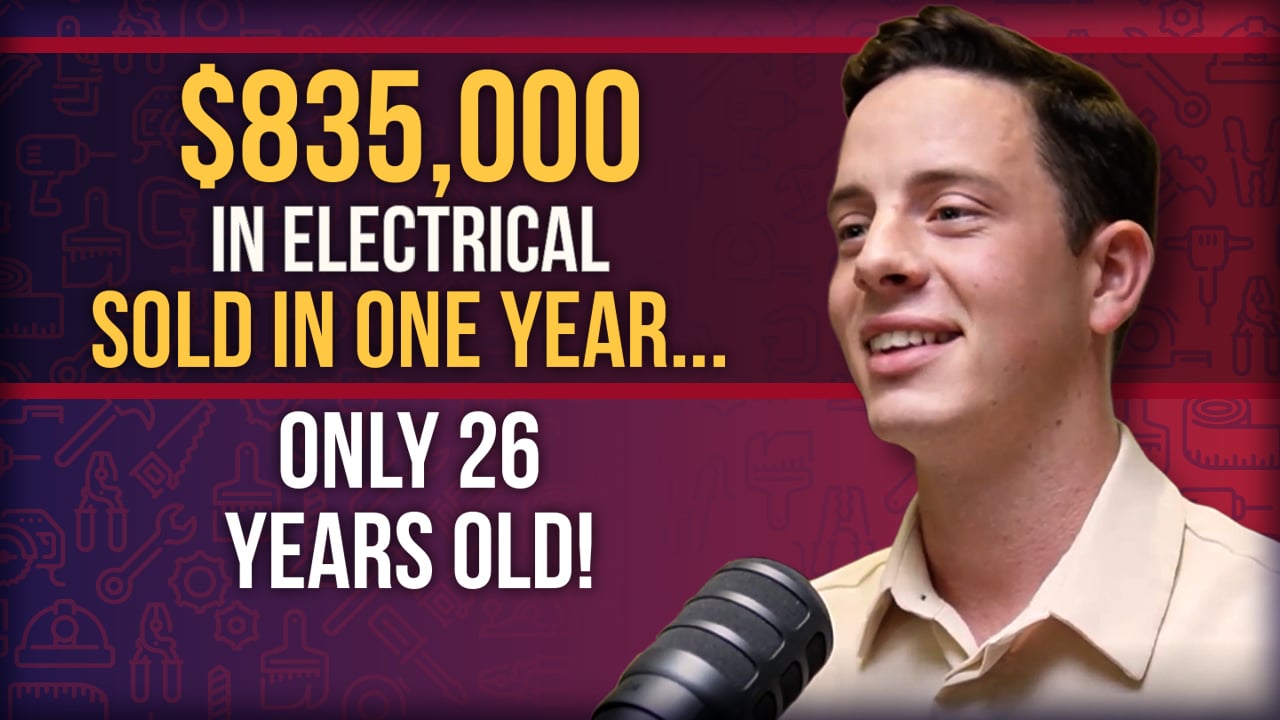I Need the Plumber & Air Conditioning in Port St. Lucie, Florida, Delivers Impeccable Service Thanks to Its Tremendous Team That Knows the Value of Every Call & How It Impacts the Business’ Bottom Line
This story is an approximate transcription of a “The Successful Contractor” podcast interview with Martin Carpenter. “The Successful Contractor” podcast, powered by Success Group International, is a show for residential contractors about residential contractors. It chronicles business journeys, shares insights, and celebrates successes in this wonderful industry of the trades and tradespeople.
Two elements of a business typically determine its success: how well it treats its customers, and how well it is managed. In the case of I Need the Plumber & Air Conditioning in Port St. Lucie, Florida, this small residential-service company is absolutely thriving due to how it handles both.
“Micromanaging the numbers, that’s my job. Maritza manages the overhead.” These are the words of its owner Martin Carpenter, who owns I Need the Plumber & Air Conditioning with his aforementioned wife, Maritza. “You can be a very successful one-, two-, or three-truck operation, like we are, as the profit is there. I’m proof of it.”
Yes, Martin and Maritza most definitely are. “In 2019, our gross profit was 77 percent, and we had 23 percent job-costing. Our margins were excellent. And I’m doing that with 1.2 calls a day, which is crazy. Our average ticket was $606,” Martin explained. “Coming into this year, our gross profit is running at 74 percent and our job cost around 26 percent. So, we’re losing a little bit, but we’ve hired an additional technician, so that extra truck is on the bill. But our average ticket is up to $749 in plumbing so far.
To listen to Martin talk about his gross profit dipping to 74 percent, a certain discontentment echoes in his voice. Never mind, most every other contractor in the country would beg, borrow, and steal to enjoy such margins. It’s not enough for him. That speaks to why Maritza and he have been successful.
This married couple thrives not only due to their understanding of the financials—ultimately, they comprehend above all else it is customers that drive success. The happier homeowners are, the more they spend. And the only way to have happy homeowners is to have skilled, knowledgeable technicians serving them.
Martin employs an extraordinary process to grow his own technicians these days—which is detailed in the story—but beyond the communication and technical skills, I Need the Plumber & Air Conditioning’s technicians have helped the company grow profitable because Martin takes the time to explain what profit is—and stresses how important it is to them.
“I show the guys the numbers, our [Daily Management Essentials Report]. I bring it out. We go over it. I show what happens when we get a call-back, what it really costs. And I never say it is going to cost me money. Oh, no, it’s going to cost all of us money. I teach the guys about everything in my company,” Martin stressed.
“Our guys know they have to treat every customer like they’re the last one they’ll ever have. And they know that they need to be intentional in how they do their work,” Martin said. “Those are the reasons why we never have call-backs and have such happy clients. It’s why we’ve been successful.”
Read more about Martin and Maritza’s tremendous story in the contracting world, how they’ve overcome significant obstacles, and how they’ve attained their level of success today.
Martin, could you share with everyone the background of your company?
Our company is probably just about six years old now, from startup. We have three technicians in the field, three trucks. We just added our latest truck in January. One technician is fully cross-trained for plumbing and air conditioning, and one technician is a plumber learning air conditioning. And the other is just a straight-up plumber. My wife, Maritza, is in the office. She wears lots of hats. She runs the whole office, financially, everything that happens in the office is pretty much all her, from permits and licensing. I can’t say enough about Maritza.
What’s revenue look like the last couple years? How’s growth been?
We started the business from scratch, with zero customers and no employees. I hired our first employee maybe six, eight months out and we started clawing our way into the marketplace at a pretty slow pace. We’d gotten up to around $460,000 in revenue within about three years with one technician in the field, that was me, and a helper. That’s about the time where I had a heart attack, actually. We’d just hired another technician.
Oh, my goodness, what happened?
I didn’t even know what a heart attack was. This was a major one—I almost died. I was knocked cold for about five to seven days, and I had to rethink what I was going to do at that point, because I couldn’t really work in the field anymore. I had to reconfigure the whole business. That was a big turning point for us. I had to turn business down. I let an employee go. I kept one of my technicians. And we got completely out of air conditioning for that period of time. That was in July 2018.
Wow. Before we get into how you moved forward, let’s continue your story from the beginning. How did you get into the trades?
I come from a family where my grandfather was a plumber. Uncle Bill was a builder. My father, believe it or not, had nothing to do with plumbing. He was actually an aviation mechanic, so he was very mechanically inclined. In middle school, I worked for a good friend of my father who was a builder. In the summers, I worked my butt off for him and I enjoyed it. And I enjoyed seeing the wealth that it provided him and his family, so that was my inspiration to get into the trades.
As I progressed, my real business inspiration was probably my father-in-law. He was an executive for Raytheon™, and a lot of times he’d come home it wasn’t enough for him. So, he had a business on the side where he, believe it or not, did appliance installation. And I would go and help him. That gave me the base of where I really wanted to run my own business. Then I had an appliance-installation business that I was running on the side at the same time I was getting my license for plumbing. So, I had a foundation of customers when I started [the plumbing business].
Now, that wasn’t in Florida, was it?
No, that business was in New Jersey. I started that plumbing business in 1999. It was me and my brother actually came into the plumbing field, as well. I persuaded him. What I’m leading up to is how I got involved with SGI.
Yes, please, share the story.
My brother was a new-construction plumber for about a year and he came to my house, and I got a letter from one of my competitors. I told him, look, they’re going to pay X dollars because you’re licensed. So, he goes to the competitor, with my urging, and applies for the job. He doesn’t have any service experience. I told him not to worry. Just call me! [Laughter] I’ll tell you what, four times a day for about six to eight months, I’d be talking him through stuff. At that same time, they sent him for SGI training, and he came back and he turned into their top guy.
Wow! He went to SGI sales training back then?
Yes, and he came back and beat out everyone, including the family members. That’s when he told me about SGI. I decided, “You know what, I don’t know how to run a business—I’m going to go and learn.” That was around 2003.
Back then, after Profit Day™, you went to Summit. Talk about that week.
They inundate you with material. [Laughter] I had to buy an extra big duffel bag just to bring it home. Anyway, the most important thing I learned—and I do this after every job is done—I look at every job. Back then, I’d get a pen and paper out. I’d figure out how much money we made on the job, whether we priced it correctly. I’d sit in the truck, and I’d show my ride-along tech how to do it, too. My average ticket back then was about 500 bucks.
How did you train yourself on how to properly run service?
I talked to other members, coaches. And the first thing I did was the StraightForward Pricing® Guide. That was the number-one thing. I mean I brought the sample guide out in the field, the first day. And I picked up their pricing, which was very close to ours. And I love the fact that it was such an amazing tool, even back then, and it’s nothing compared to what it is now.
The StraightForward Pricing® Guide helped build value. We started wearing uniforms. Back then people were like, oh, I thought you were a police officer. [Laughter] Then, I’m pulling up in a nice truck that’s fully stocked. You’ve got everything that the customer needs. I have the guide and this new thing called The Diamond Club™. People thought I was a franchise when I’m really just a little shop. People are impressed. And that’s really all thanks to SGI. I had an open mind going in though. I knew I had to change. And it’s not easy.
Was Maritza helping you at that point?
Back then—in the very beginning—I was the guy answering the calls, but within that first year, I set up a small office and a call center, basically. And then I went into hiring people to answer the phones, and I didn’t have much luck with that. I didn’t really know how to train them—even with the material we had, I didn’t really know what to look for in the person, or how to look at the person’s character. I struggled with that back then.
How did you eventually get to Florida?
Okay, 2005 the business was growing. I was ahead of all my vendors. I was paying them biweekly. When I joined SGI, I had around 30- to 40-thousand dollars in debt. And within a year and a half all that was paid off, and now I’m paying vendors ahead of time. But that was the time my first wife decided she wanted a divorce.
My accountant said, “She’s going to want a piece of the business. You need to make the business look bad.” He said to run up debt, which I did. And it ended up that she never wanted any of the business.
So that was a life-changing event for me. I ended up in a pretty bad place. I put the business on cruise control. And it actually survived. And I was there, but not really. I mean the guys knew what they had to do. The calls came in, nothing was really maximized, but the business survived. And I did downsize it eventually. And during that whole process, I decided I really didn’t want to live in New Jersey anymore. I met my future wife, who is my wife now, Maritza. But the one thing I will say is the business survived because it had a solid foundation under it. And it had a solid foundation because I learned how to take care of customers. I learned how to treat your customer like it’s the last one you’ll ever have. When I did leave New Jersey, some of my customers said things to me that made my heart almost break. But it was SGI that really helped me build that foundation.
When did you get to Florida?
We bought our house in 2009. But Maritza and I had multiple properties we had to deal with still up north, so we kind of vacationed here. Our one-year plan to move turned into four years. It took us until 2014 to finally move here.
So, you went into business when you finally moved?
I did. I underestimated how hard it is to start a business, especially from scratch. I don’t think I remembered the pain of what it really took to do it.
How did you find customers back then?
We started with the Yellow Pages®, YP. And the reason we did that is because Florida, I thought the older people still looked at the Yellow Pages®. Turned out to be a disaster. They talked me into splitting the budget between air conditioning and plumbing, and that was a big mistake. I’ll be honest, I’m just not very good at marketing. Either I have terrible luck or I just don’t know how to do it. I’m still trying to figure it out.
I’ve done the math many times. Right now, we have 1,650 total customers. That’s 1.2 customers a day. That number haunts me. That’s where most of my issues lie right now. We need more calls. It’s also the reason why I still treat every customer like they’re my last.
Did you rejoin SGI right away at that point?
No. No, as it turns out, SGI was being sold at that point. The transition into Rebecca’s hands and things weren’t as organized I guess. Direct Energy™ was still the owner. Then, in 2016, SGI called. Of course, I went to the first Profit Day™ and signed up on the spot.
You rejoined in 2016. What did you implement once you came back?
Again, the first thing was StraightForward Pricing®. And I’d been away for a number of years and the new guide—I love the new guide. It’s a wonderful tool. So that was the first thing we did when we got back—we implemented that immediately. Another thing that I implemented pretty much right away was The Lifetime Diamond Club™, which was new. And as a business owner, it’s scary. But we’ve done that. And we did some Executive Perspective, and we did some Service Essentials. I took one of my technicians there. And I’ve also implemented the SGI onboarding program, using that formula, rather than just taking a new guy and throwing him in a truck. We don’t do that anymore. And I’m also hiring guys that are not plumbers.
Then, the heart attack comes in 2018. Could you share what happened?
Yeah, and for the rest of our SGI family, if you do have any signs, do something immediately. I had some signs—I had some chest discomfort while I was sleeping, and I thought it was muscle-related, so I tried going to the gym and doing some exercises. And it turned out I was probably in congestive heart failure. And I’m still working in the field. I’m doing installs in the hot summer. And I had a heart attack. And it was a bad one. I was in the hospital five days maybe. And when I left the hospital, they had a defibrillator on me because my heart was damaged. The main part of the heart was only pumping about 20 percent.
So, Wednesday night, I was released from the hospital, and I was very upset about that. I mean, I didn’t know what a heart attack was—no one ever had a heart attack in my family, and they make it seem like such a nonchalant thing. So, I was upset. My life had changed. Luckily, when I started the new business, I invested in a disability insurance policy.
Now, I was back in the office by Thursday morning—now, I couldn’t do anything. But I had to get back in the office. And I’ve got one technician who’s got virtually no experience. And now I’m thinking, how am I going to proceed here? I can’t do the air conditioning. This guy can be my hands and I can train him at the same time and that’s where we took it.
But those days are when I decided I’ve got to change what I’m doing. I can’t be in the field. I’ve got to get in the office and run this company, not work in it.
How else did the business change at that point?
Right off the bat my SGI coach at the time, he gave me some advice. He’s like, “You know what, step back out, slow things down. Any overhead that’s not 100 percent necessary, shut it down, explain to your vendor what’s going on.” We did that. And we were able to actually survive.
At that point I said, “I’ve got to train this technician to get out there in the field to be on his own, mostly. And I’ve always got the phone. I’m still very attached to my technicians, always have been. If there’s anything in the field they don’t understand, call me. But that’s when I had to step back and release. It was extremely difficult.
How did you manage the ride-alongs?
I had already taught my tech the presentation, our credibility statements. And I’ve got my SGI checklist for that. And then after the call, I work with him. If he got into the weeds on the call, I helped him out, but I stayed quiet for the most part. And while he did the physical work, I watched and gave him pointers.
Eventually, you hired another technician. Did you ride-along with him the same way?
Yup. Hiring the right people is the most important thing you can do. We hire based on character. We do extensive background checks. They take multiple tests, so before they even get to really interview with us, they’ve spent two hours on the computer at least, just testing. And that gives me an idea of their character. And they’ll interview with us three to four times before they’re hired.
What kind of personality seems to work best as a service technician?
I’m looking for a people person first, somebody that can communicate well and is outgoing. Mechanical somewhat has to be there because they do have to learn, but it’s nowhere near what people think it should be. That’s easy to teach. And I want them to be honest. Honesty will come out in those tests. And if you find those people, I take a person that’s totally green and if they fit that criteria. He’ll run certain types of calls for three months, and they’ll do it the way I trained them to do it.
Do you train with the new techs every day?
Yes. We train the techs on two major things—efficiency and no call-backs. That’s how we’ve been so profitable.
Do you do morning huddles with everyone every day?
Yes, every day. They’re general huddles. We meet in the back of the shop, and we talk about what happened in the field. And I keep it a little light because the guys need to vent and they need to vent to each other. But keep it enjoyable. I never reprimand them. I’m not the boss anymore. That is the most important thing. Any mistake a guy makes in the field, that’s not the time to handle it in a huddle while you’re trying to figure out what’s going to happen for the day. So, we keep it light and I keep it positive.
I might look at the schedule and say, “Hey, Landy, you’ve got just a fantastic opportunity for IAQ, you can knock it out of the park.” I try to build them up, give them some confidence on the way out the door.”
You mentioned earlier that you use the SGI onboarding training, too?
Yes, we do! We do training, a lot of role-play training. I probably use about 10 percent of all the tools SGI has for training. I would tell my fellow members out there that if you hire a new technician, the onboarding program with SGI is fantastic. But we do use the onboarding training. I would recommend to any member to get yourself a TV in your shop, use your laptop, and bring all your technicians in to review it, not just your new tech.
You have everyone on the team go through onboarding again?
That’s right. It never ends because if you think about what we do for a living, people think we just fix things. That’s not it. Our job is very complicated. Being a professional service technician is very complicated. There are a million steps that have to be taken, and if you don’t take them, you don’t have success. It’s almost too much to remember so we have to keep training.
How often do you do more in-depth training?
We try to do training on Tuesdays and Thursdays, which we’ll use something from SGI, or we’ll role-play, or we’ll talk technical. If something happens in the field, there’s a new product, we have to do technical training periodically, so we do that. And we also do OSHA™ training. Safety’s a big thing for our guys.
Maritza gets involved in the training. She’ll come back for certain trainings, especially with the role-playing. She’ll actually step in as a customer with some of the technicians. And our shop is small so if she’s up in the front office, she can hear us training. It says a lot for Maritza because she wears so many hats in that business—it’s just tremendous what she does.
What is Maritza’s background?
Accounting. She was a CFO and worked in corporate restructuring. She’s done some amazing things in her career. To have her in a business this size is amazing. She’s an expert at the financials, gets all the numbers we need, controls the inventory. She’s tremendous. And it’s not just the numbers. It is the calls that come in—she books around 80 to 85 percent of the calls that come in. And she does the permitting. She does the licensing. She is at the point where she is about to burn out, so I’m trying to help her out more in the office with those things.
Change of subject, but all the changes you’ve made, have you had any fellow members you’ve relied upon as a resource?
Oh yes. I can’t say enough about Donna and Steve Huff. Other members are one of the great things about SGI. I met Steve and Donna through SGI. Steve and Donna have mentored us over the years now. And I’ve been to his operation and I know all the guys. And Steve—I call him anytime—and he’s always there. To see where Steve has taken that company from where he started, and he’s turned it into a multimillion-dollar company. And Steve and Donna have run it like Maritza and me do today. They’re so inspiring. And then to see how they’ve groomed [their general manager, Nick] and sold the company to him. Their business is where we want to go.
What advice do you have for other members, given how much you’ve overcome and accomplished at this point?
I think probably most SGI members are smaller companies, and I think whether you’re big or small, it’s not easy to run a business. Stay focused on what you need to do to get your numbers. I said the most important thing for my company, and I still do, to this day, almost every single job that comes in I look at the numbers. We’re on ServiceLine™, and with it, I can look at the job and see if we made money. If you’re driving a boat, and you’re headed toward a rock, but you don’t know you are, you can’t change the direction. Managing your business by the numbers is the same thing. You have to know them to avoid those rocks.
Where do you see the business in the next 6 to 12 months?
Our goals are pretty moderate. We’re going to exceed our goal this year by around $120,000. And that’s with the setbacks because of COVID-19. One of our technicians has COPD, so we didn’t have him for two months. So, we had a truck down, but he’s back. But we’re back on point. We’re going to make it. And we’re going to make a good profit.
Any last things you’d like to say to SGI?
Yeah, use SGI. Use SGI to its full potential. I network, I’m doing the TAG meetings. Use all the tools, or as many as you can, and go through everything. Sit on your off-hours and just look through all the different materials. I mean, there’s a ton of material. Get your numbers right. Know your numbers every single day, and no matter what size you are, or what size you want to be, whether you’re a $100,000 company or $100 million company.
Not a member yet? Want to explore the SGI Membership benefits? The first step is attending Profit Day. You can also give us a call for more information! 866-344-0789




